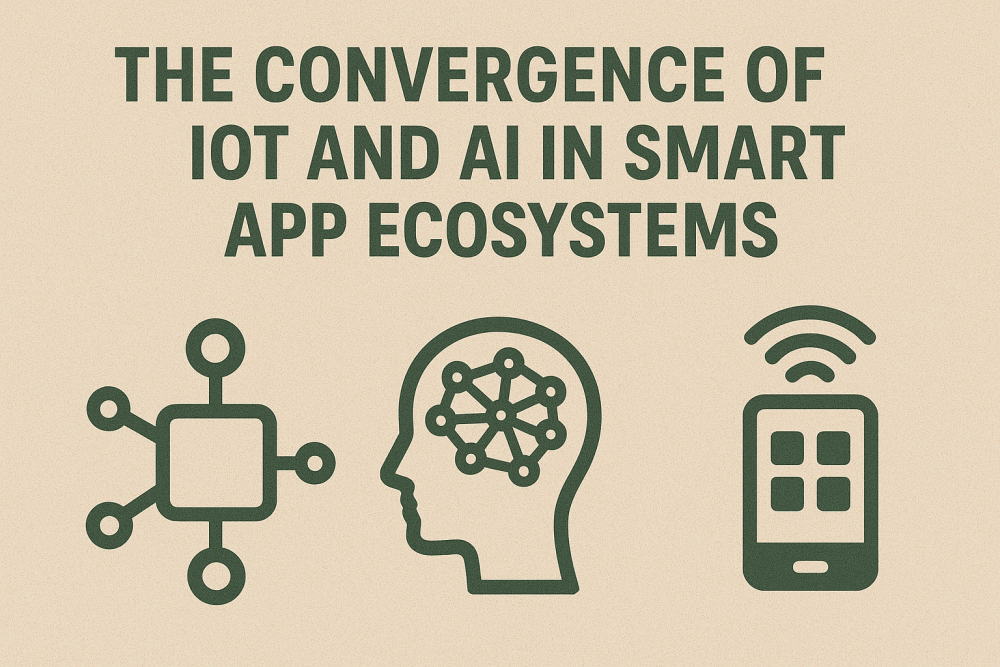The rise in growth of digital technologies has paved the way for an exciting convergence between Internet of Things (IoT) and Artificial Intelligence (AI). IoT provides connectivity and data, while on the other hand AI delivers intelligence and decision-making skills. Together, they are building intelligent app ecosystems which can revolutionize sectors, improve user interactions and facilitate sustainable options in the coming time. This combination is not a vision anymore but is currently influencing how we work and engage with technology.
How IoT and AI Complement Each Other
IoT primarily focuses on linking devices and facilitating their ability to gather and exchange data. IoT networks generate enormous volumes of data from wearables, smart home appliances and industrial sensors. Nonetheless, this data possesses no value without intelligence. Herein lies the role of artificial intelligence. AI analyzes the data, patterns and offers useful insights. For example, an IoT-connected smart thermostat can adjust the temperature of a room based on AI-identified usage patterns, promoting comfort and energy conservation.
Building Smarter Applications
The combination of IoT and AI is propelling the growth of intelligent applications in various industries. In the field of healthcare, wearable gadgets track heart rates and oxygen levels, and when integrated with AI, they can anticipate health risks & notify users or physicians instantly. Moreover, analytics powered by AI in connected vehicles assist in forecasting road conditions, optimizing fuel efficiency, and facilitating self-driving in transportation industry. These programs are now an essential part of the ecosystem designed for continuous learning and improvement.
Enhancing User Experience
A significant advantage of integrating IoT and AI into application environment is the capability to offer personalized recommendations. AI algorithms analyze user actions and behavioural trends collected from devices to deliver tailored experiences. For instance, intelligent fitness apps adjust exercise plans according to live performance tracking, while AI helpers in smart homes assist in modifying lighting, control music, and create schedules to fit individual routines. This level of customization is setting new benchmarks for convenience and user experience.
Industrial Applications and Efficiency Gains
In the industrial sector, IoT and AI are coming together to revolutionize operations. Smart manufacturing applications, for instance, utilize IoT sensors for monitoring equipment status while AI forecasts possible failures and recommends maintenance prior to malfunctions happening. This not only saves costs but also reduces downtime. IoT-enabled devices in logistics provide real-time shipment tracking, while artificial intelligence (AI) improves routing and forecasts demand to enable more effective supply chain operations. These ecosystems are enhancing productivity while reducing environmental impact.
Security and Reliability in Smart Ecosystems
Security becomes a critical issue as IoT networks grow. The likelihood of cyberattacks increases as millions of linked devices exchange private information. AI addresses this issue by identifying unusual patterns, detecting threats and improving system robustness. Security features powered by AI are progressively integrated into modern app ecosystems for protecting user privacy and ensuring data integrity. This focus on reliability is essential to fostering trust and encouraging the widespread adoption of IoT & AI solutions.
Sustainability and Smarter Resource Management
The convergence of AI and IoT is important for sustainability. By incorporating Internet of things (IoT) and AI into intelligent applications, smart cities can optimize energy grid management, track air quality & lower water waste. For homes, smart applications enhance appliance efficiency to reduce energy consumption and lower carbon emissions. This combination illustrates how advancements can synchronize with global objectives for environmental sustainability.
The Future Ahead
The future of smart app ecosystems lies in deeper integration of IoT and AI, supported by advancements in cloud computing, 5G connectivity and edge AI. As these technologies progress, applications will develop to become more autonomous, adaptable, and able to grow. The influence of the convergence of IoT and AI will keep growing, affecting areas such as healthcare, smart cities, and industrial automation, redefining how humans and machines collaborate in everyday life.
Conclusion
The combination of IoT & AI is generating robust smart application ecosystems which are transforming industries, enabling sustainable growth and enhancing user experiences. These ecosystems are closing the divide between connectivity and decision-making by transforming raw data into actionable intelligence. With the increase in adoption, they offer the potential to increase efficiency & improve convenience while tackling some of globe’s most important issues. The convergence of IoT and AI is not just a technological evolution, it is a pathway to a smarter, more connected future.
